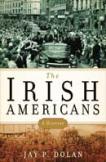From Prejudice to Power
Fundamental to the American dream is the story of immigrant peoples beckoned by the Statue of Liberty. In Emma Lazarus’s poem, inscribed on its base, the “Mother of Exiles” welcomes “the wretched refuse” of foreign “teeming shores,” “huddled masses yearning to breathe free.” Inevitably this is a heroic story, all the more because great obstacles are overcome to realize the full promise of the land of opportunity. In many ways Irish America represents the archetype of this heroic narrative. The greatest concentration of Irish immigrants were exiles from the Great Hunger of the mid-19th century, wretched indeed as they escaped starvation, disease and enduring poverty, only to be greeted with “No Irish Need Apply” in their less than welcoming adopted homeland. A little over 100 years later, one of their own was inaugurated president of the United States, and as a group the Irish Americans surely had arrived, ranked among the best educated, wealthiest and most accomplished ethnic groups in American society.
Much has been written by historians, sociologists, political scientists and biographers charting the contours and complexities of this triumphant long march. Now retired from the University of Notre Dame, Professor Jay Dolan is one of the leading historians of the Irish in America and the history of the American Catholic Church. Here, rather than offering a work of heavy scholarship, he provides a synthesis of this wide-ranging literature for a broad audience, albeit likely an Irish-American one. He brings to this effort decades of research and teaching, the wisdom and judgment that come with such lifelong endeavors and the confidence that translates into an easy, entertaining and very informative read.
But such broad surveys of complex stories can be distinguished as much by what they omit as by what they include. There are many ways to view the history of Irish America—sociological, cultural, religious, political—and Dolan acknowledges in his preface that this story will be only a partial one that focuses on religion, politics, labor and the impact of Irish nationalism. Irish-American literature, sports and the entertainment field in general receive the briefest of references. While occasionally the female experience is differentiated from that of the male, there is very little gender analysis. No new theoretical frameworks in which to place immigrant communities are explored. It would be churlish, though, to criticize a book of such broad sweep for its omissions; yet concern lingers that the more lovingly stereotypical representations receive an attention that could be more critical.
Dolan starts promisingly by reminding his audience that the first wave of Irish immigration to colonial North America was largely Presbyterian in its denomination, and that those Catholics who came over remained largely unchurched because of the scarcity of their clergy. They were followed by a smaller group of political exiles in the early 19th century, who added hostility to England into the mix and found their way into the Jeffersonian Party.
But it was the Famine immigration that forged the identity that most concerns Dolan. That is when the Irish Presbyterians became Scotch-Irish, and the real Irish were exclusively Catholic. And that is when an American Catholic Church began to emerge from humble beginnings to Promethean heights, overwhelmingly staffed by Irish and Irish-American clergy. The story now becomes a familiar one of prelates and politicians—Archbishop John Hughes building that monument to American Catholicism, St. Patrick’s Cathedral in New York; Boss Tweed and Tammany Hall. All this was made possible by the concentration of so much of the Irish immigrant population in the cities. But to what extent were machine politics a reflection of an Irish genius for political mobilization, or simply a function of urbanization? Other ethnic groups had their big-city political machines, though admittedly the Irish may have set the mold. But Dolan does not address such questions. Rather, he offers a series of vignettes highlighting notable Irish-Americans.
This is one of the problems as well as one of the many delights of this book. Irish America is not defined except, it seems, in reference to a place of origin. What, indeed, constitutes Irish-American identity? Dolan says the Irish have a gift for politics and are endowed with charm, wit and eloquence, which make them effective union leaders, priests and politicians. Are these national traits or simply the characteristics of the most successful Irish-Americans? Is there anything that links the Kennedys to the anti-busing crowds of South Boston or the Westies of Hell’s Kitchen? Dolan’s Irish-Americans reside mostly in New York, Boston and Chicago. Do they become less Irish as they leave the cities for the suburbs, or bypass the cities altogether? Irish-Americans were fairly solidly behind the Democratic Party until the 1960s, and then they become as politically polarized as the rest of the nation. They were equally polarized on integration, despite being visibly hostile to African-Americans.
The underbelly of Irish-American behavior is acknowledged, but receives very little attention. The crime gangs of Hell’s Kitchen and South Boston, for example, are accorded a single paragraph, and Irish urban racism receives only a little more consideration. The political machines of New York, Chicago and Boston, with their colorful bosses and corrupt practices, are presented as progressive institutions that take care of the huddled masses and open the doors to upward mobility. Indeed, this book is the most fun to read when it covers those bosses. It is also most authoritative when it covers the Catholic Church, about which Dolan is so clearly an expert. But he tends to use Irish and Catholic as if they were interchangeable.
The Irish Americans is, after all, only a survey, masterfully done within the limits set by Dolan, and lively and engaging in its narrative. What it is meant to do, it does—it offers an appealing and inspiring history of Irish America to the many Americans of Irish descent.
This article also appeared in print, under the headline “From Prejudice to Power,” in the March 16, 2009, issue.








